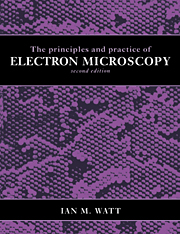Book contents
- Frontmatter
- Contents
- Preface to first edition
- Preface to second edition
- 1 Microscopy with light and electrons
- 2 Electron–specimen interactions: processes and detectors
- 3 The electron microscope family
- 4 Specimen preparation for electron microscopy
- 5 The interpretation and analysis of micrographs, pages 189 to 223
- The interpretation and analysis of micrographs, pages 224 to 262
- 6 Analysis in the electron microscope
- 7 Specialised EM- and other microscopical and analytical techniques
- 8 Examples of the use of electron microscopy
- Appendixes
- Bibliography
- Name index
- Subject index
Preface to first edition
Published online by Cambridge University Press: 05 June 2012
- Frontmatter
- Contents
- Preface to first edition
- Preface to second edition
- 1 Microscopy with light and electrons
- 2 Electron–specimen interactions: processes and detectors
- 3 The electron microscope family
- 4 Specimen preparation for electron microscopy
- 5 The interpretation and analysis of micrographs, pages 189 to 223
- The interpretation and analysis of micrographs, pages 224 to 262
- 6 Analysis in the electron microscope
- 7 Specialised EM- and other microscopical and analytical techniques
- 8 Examples of the use of electron microscopy
- Appendixes
- Bibliography
- Name index
- Subject index
Summary
Electron microscopes have been available commercially for 45 years now, and several thousands are in use throughout the world, operating in a wide range of fields. Although they started out as transmission instruments, with consequent limitations for certain types of examination, the introduction of the scanning microscope only 20 years ago revolutionised electron microscopy and broadened its scope very considerably. More recently the availability of a range of analytical techniques and the development of both hybrid and more specialised models of microscope have made it necessary to consider which member of the e.m. family is most appropriate to a particular examination, and how it can best be employed. This book has been written for anyone whose work or study encounters the results of electron microscopy, whether in biology, medicine or technology. Its purpose is to describe in simple terms the range of instruments and techniques now available and to illustrate how their capabilities are employed. The book mentions some of the factors which have to be considered and optimised by the microscopist, in the hope that the user of the results of microscopy will feel he understands more of what is going on, even though he may never see an electron microscope in operation. If this results in a closer collaboration between the ‘customer’ and the microscopist it will be to the advantage of both.
- Type
- Chapter
- Information
- The Principles and Practice of Electron Microscopy , pp. ix - xPublisher: Cambridge University PressPrint publication year: 1997

